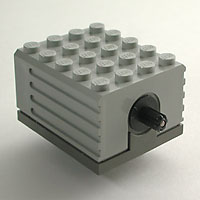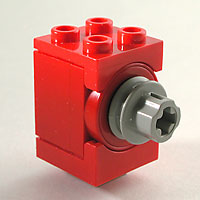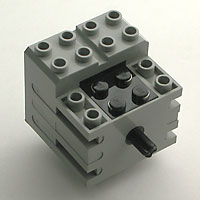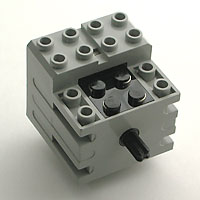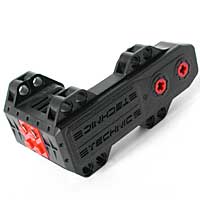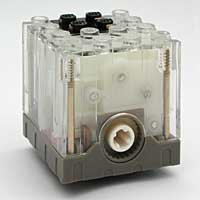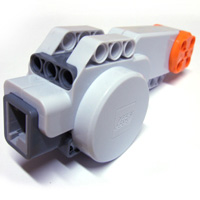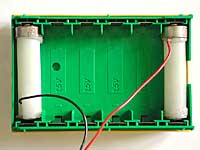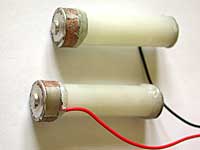![]()
![]()
![]()
![]()

Lego® 9V Technic Motors compared characteristics


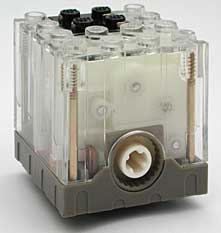

May 2006 update: now includes NXT motor |
See also this comparison page.
Thomas Avery has also performed measures on 5292 motors, see Lugnet thread.
The roster
|
Electric Technic Motor 9V Lugnet Partsref 2838c01, Peeron 2838c01, Lego 74569 The older 9V Technic motor (1990). Ungeared, it has a high rotation speed and low torque, so for most applications it requires an external gear reduction. |
|
Electric Technic Micromotor Lugnet Partsref 2986, Peeron 2986, Lego 70823 Appeared in 1993, this small, light weight motor turns slowly and offer low torque - but respectable torque for its size. Must be used generally with pulley, top and base, but other motion transmissions are possible (see examples by Brian Sadowsky, with a 16t gear/clutch or a pin joiner) |
|
Electric Technic Mini-Motor 9v Lugnet Partsref 71427c01, Peeron 71427c01, Lego 71427 Since 1997, this motor replaces 2838. Geared down and quite efficient, this is the motor of choice for most applications. |
|
Electric Technic Mini-Motor 9v Lego 43362 In 2002, Lego replaced 71427 motor with a new type, 43362. Externally almost identical, its internal structure is very different. Performances are almost as good, and its weight is much lower. |
|
Electric RC Race Buggy Motor Introduced in 2002, this motor appeared with 8475 RC Race Buggy. Very powerful, it also consumes a lot of energy. Not recommended for use with a RCX which can't deliver the current needed by this beast. The innermost shaft hole is geared up by a 23/17 factor. Only the outermost output is tested below. |
|
Electric Technic Motor 9V Geared This motor was first included in 4094 Motor Movers set (2003). Provides an axle hole with friction, allowing to choose axle length without the need of an extender. Flat bottom allowing easy mounting. |
|
NXT motor This motor is specific to the NXT set (2006). Includes a rotation encoder, returning to the NXT the position of the shaft with 1° resolution. Because of the special connector of this motor (non-standard phone plug type), a cable adapter is required to drive this motor with regular 9V sources. Not recommended for use with a RCX which can't deliver the high current that this motor can consume. Slow rotation speed, minimizing the need of external gear train. |
Weight
|
|
|
|
|
|
|
48g |
10g |
42g |
28g |
55g |
40g |
80g |
Supposed to be equivalent to 71427, 43362 motor is 30% lighter. This is generally an advantage, except when the motor is used as a counterweight, or to balance the structure, for example in COG-shifting walkers.
No-load characteristics
Test conditions: motor is powered by a variable, regulated
power supply. An ammeter measures current flowing through the
motor, a voltmeter monitors tension across. The rotation speed
is measured by a RCX equipped with a light sensor, looking at
an half-white/half
black cylinder.
9 V supply |
|
|
|
|
|
|
|
Rotation
speed |
4100 rpm |
35 rpm |
360 rpm |
340 rpm |
1300 rpm |
460 rpm |
170 rpm |
No-load current |
35 mA |
6 mA |
3.5 mA |
9 mA |
160 mA |
31 mA |
60 mA |
43362 has a higher no-load current than 71427, probably
caused by higher internal
friction. 47154 has a fairly high no-load current, because
of its 5-stages gear reduction. But it uses big-tooth gears
in the last stages, probably much more sturdy that the 2-stages,
thin-tooth 71427/43362 internal gearing. The 5292 also exhibit
very high no-load current, here again caused by internal friction.
This explains also the break in its speed/voltage curve.
As is usual for DC motors, rotation speed is proportionnal
to voltage applied to them, this can be seen on graphs below.
No-load current depends little on voltage.
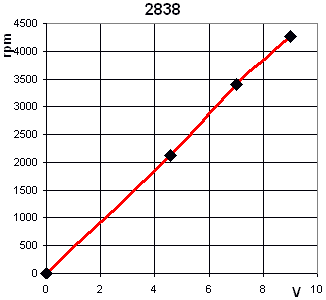
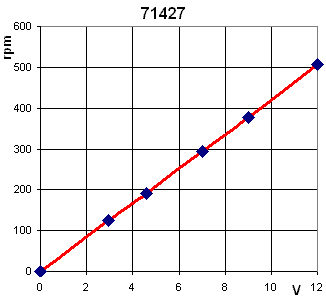
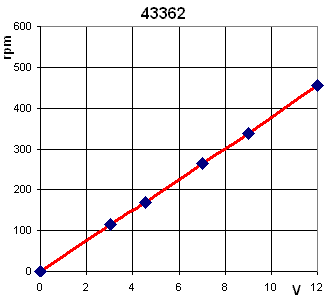
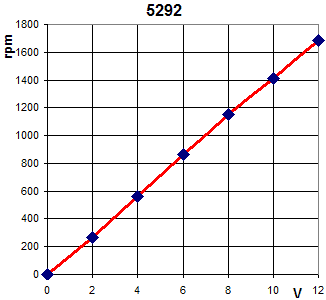
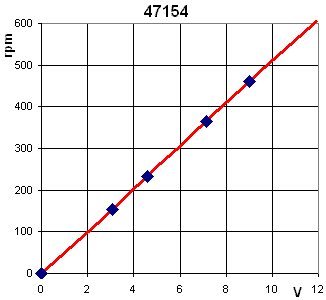
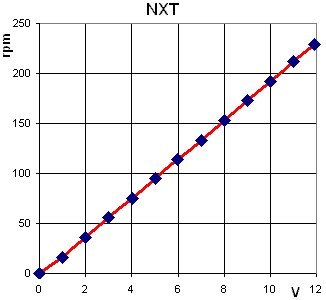
Stalled characteristics
Stalled current consumption is simply measured with motor
axle shaft locked by hand. Stalled torque is established from
the maximum weight that can be lifted by the machine described
below. Note that stalled torque measure is VERY imprecise
(this is especially true for 5292 motor)
9 V supply |
|
|
|
|
|
|
|
Stalled torque |
0.85 N.cm |
1.6 N.cm |
6 N.cm |
5.5 N.cm |
12 N.cm |
6 N.cm |
50 N.cm |
Stalled current |
700 mA |
80 mA |
360 mA |
340 mA |
3.2 A |
580 mA |
2 A |
Take care to avoid extended period stall condition, as power dissipated in motor case is quite high (6 Watts for 2838, 3 W for 71427) will cause a rapid temperature rise. Note that 71427 and 43362 motors, equipped with a thermistor, should be protected against frying (not tested though !!!). 5292 motor is probably protected too, since stalled current decreases quickly. 47154 protection can be seen easily through clear case.
The NXT motor is also protected by a thermistor (Raychem RXE065 or Bourns MF-R065). That means that the high 2A current (and associated whooping torque) can be sustained only for a few seconds.
Here is the setup used to measure motors under load. Electrical power is measured with voltmeter and ammeter. Mechanical power delivered by the motor is evaluated from the time used to lift the weight by some height (5 cylinder turns - the first two turns are not counted to eliminate initial acceleration). Torque applied is obtained from weight and cylinder radius.
Cylinder is directly placed on motor axle shaft, except for 2838 motor where a 1/5 gear reduction was used. Additionnal friction introduced may have somewhat impacted 2838 efficiency, but anyway this gearing is necessary for most applications. Torque displayed for this motor corrects gear reduction. The fast 5292 motor was also measured with a 1/3 gear reduction.

|
Torque |
Rotation
|
Current |
Mechanical |
Electrical |
Efficiency |
6 V |
0.45 N.cm |
580 rpm |
0.32 A |
0.27 W |
1.9 W |
14 % |
7 V |
0.45 N.cm |
1000 rpm |
0.32 A |
0.46 W |
2.3 W |
20 % |
9 V |
0.45 N.cm |
2000 rpm |
0.32 A |
0.9 W |
3 W |
31 % |
12 V |
0.45 N.cm |
3300 rpm |
0.33 A |
1.5 W |
4 W |
39 % |
|
Torque |
Rotation
|
Current |
Mechanical |
Electrical |
Efficiency |
4.5 V |
2.25 N.cm |
57 rpm |
0.12 A |
0.13 W |
0.54 W |
24 % |
7 V |
2.25 N.cm |
160 rpm |
0.12 A |
0.38 W |
0.85 W |
45 % |
9 V |
2.25 N.cm |
250 rpm |
0.12 A |
0.58 W |
1.1 W |
54 % |
12 V |
2.25 N.cm |
375 rpm |
0.12 A |
0.88W |
1.5 W |
61 % |
|
Torque |
Rotation |
Current |
Mechanical |
Electrical |
Efficiency |
4.5 V |
2.25 N.cm |
50 rpm |
0.12 A |
0.12 W |
0.54 W |
22 % |
7 V |
2.25 N.cm |
140 rpm |
0.12 A |
0.33 W |
0.85 W |
39 % |
9 V |
2.25 N.cm |
219 rpm |
0.12 A |
0.51 W |
1.1 W |
47 % |
12 V |
2.25 N.cm |
333 rpm |
0.12 A |
0.77W |
1.5 W |
54 % |
|
Torque |
Rotation |
Current |
Mechanical |
Electrical |
Efficiency |
4.5 V |
2.25 N.cm |
90 rpm |
0.19 A |
0.21 W |
0.85 W |
24 % |
7 V |
2.25 N.cm |
210 rpm |
0.19 A |
0.49 W |
1.33 W |
37 % |
9 V |
2.25 N.cm |
315 rpm |
0.19 A |
0.74 W |
1.7 W |
43 % |
12 V |
2.25 N.cm |
468 rpm |
0.19 A |
1.1 W |
2.3 W |
48 % |
|
Torque |
Rotation |
Current |
Mechanical |
Electrical |
Efficiency |
9 V |
1.28 N.cm |
16 rpm |
0.04 A |
0.021 W |
0.36 W |
16 % |
12 V |
1.28 N.cm |
28 rpm |
0.04 A |
0.038W |
0.48 W |
28 % |
|
Torque |
Rotation |
Current |
Mechanical |
Electrical |
Efficiency |
3 V |
2.48 N.cm |
120 rpm |
0.76 A |
0.31 W |
2.28 W |
13 % |
4.5 V |
2.48 N.cm |
340 rpm |
0.77 A |
0.88 W |
3.46 W |
25 % |
7 V |
2.48 N.cm |
670 rpm |
0.78 A |
1.74 W |
5.46W |
32 % |
9 V |
2.48 N.cm |
920 rpm |
0.78 A |
2.38 W |
7.2 W |
33 % |
- a PTC thermistance (here an Epcos B1056). This resistor, mounted in series with the motor, has a low value when it is cold (about 1.7 ohms), rapidly increasing as temperature rises. When large current flows through the motor, self heating rises thermistance temperature and resistance value, so the current is limited by voltage drop across thermistance.
- a BZW04-15B, bidirectional transient voltage suppressor diode. This diode protects RCX from large voltage spikes that could be generated by the motor. But it also forbids applying more than 15V to the motor...
- Micromotor 2986 is at its best when space or weight is at a premium. But its mechanical power is quite low.
- Technic motor 2838 is a real power hog, with poor efficiency, but it can deliver 30% more power than Minimotor.
- Minimotor 71427 is probably the best performer of the pack overall.
- The new 43362 is roughly equivalent to 71427, with slightly degraded performances. But its light weight can be a boon for many uses.
- Clear case 47154 provides a higher mechanical power than 71427, but at the price of a somewhat lower efficiency.
- RC Race Buggy Motor 5292 is really powerful, but requires a power supply up to the task. It's not a good idea to use it with a RCX as the 500 mA current limitation won't let it unleash its power...
- NXT motor delivers a high torque thanks to its internal
speed reduction gear train. Because of that, it also turns
slowly and efficiency is somewhat reduced. This motor could
be connected to RCX thanks to a compatibility cable, but
this is not recommended for use on a RCX because the high
current it can consume is too much for RCX 500 mA current
limitation.
|
Torque |
Rotation |
Current |
Mechanical |
Electrical |
Efficiency |
4.5 V |
16.7 N.cm |
33 rpm |
0.6 A |
0.58 W |
2.7 W |
21.4 % |
7 V |
16.7 N.cm |
82 rpm |
0.55 A |
1.44 W |
3.85 W |
37.3 % |
9 V |
16.7 N.cm |
117 rpm |
0.55 A |
2.03 W |
4.95 W |
41 % |
12 V |
16.7 N.cm |
177 rpm |
0.58 A |
3.10 W |
6.96 W |
44.5 % |
The speed of 43362 motor is about 12 % lower than speed of 71427. Though this is in the range of variations measured by Steve Baker among a bunch of nine 71427 motors, my measures on three 71427 and two 43362 showed the 12 % difference between the two groups.
Speed and current vs. torque
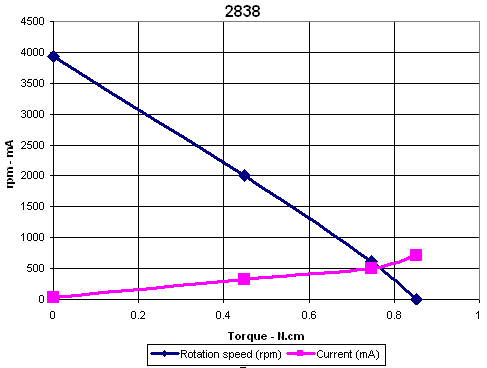
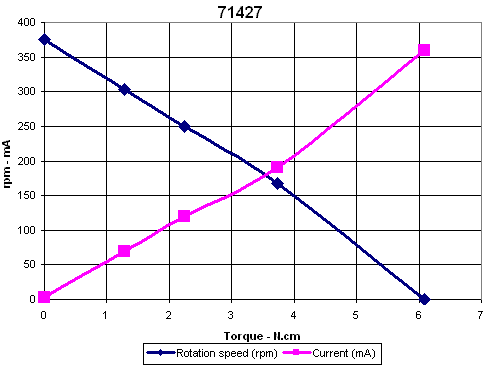
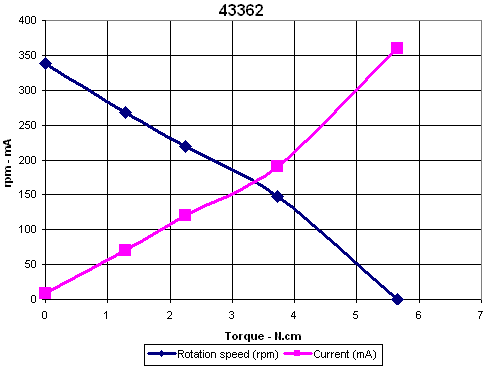
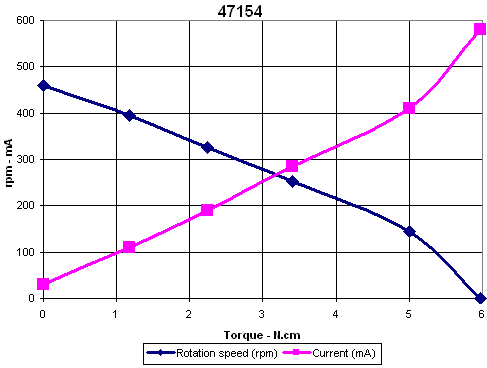
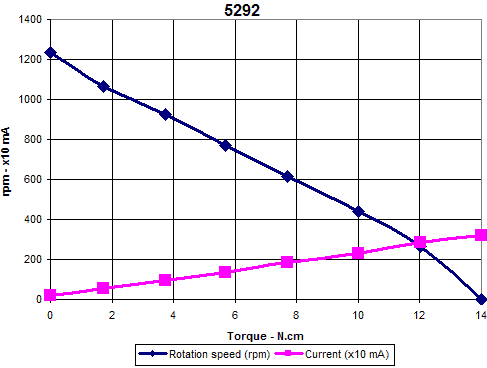
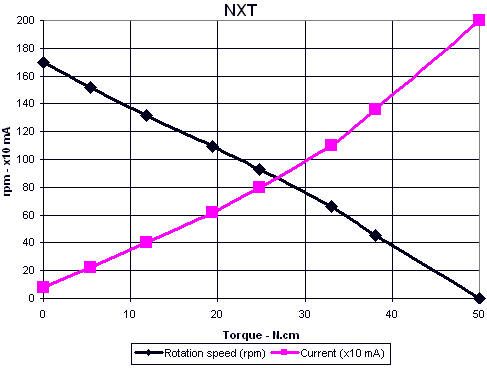
Protections
71427 and 43362 motors are protected from abuses by two devices:
A similar protection is integrated in 47154 motors, as can be seen on this photograph. NXT motor is also protected with a PTC thermistance and a transient voltage suppressor diode (D4 on this photograph).
Outputs of RCX are also protected from overload: the motor driver chip used (Melexis MLX10402 - datasheet) has a current limitation set to 500 mA, and a thermal shutdown which disable the output if die temperature rises too much.
Here is the curve limitation that I measured on a RCX. It was powered by an external regulated power supply, and tested at 9V (6 alkaline batteries) and 7.2V (6 NiCd or NiMH rechargeable batteries).
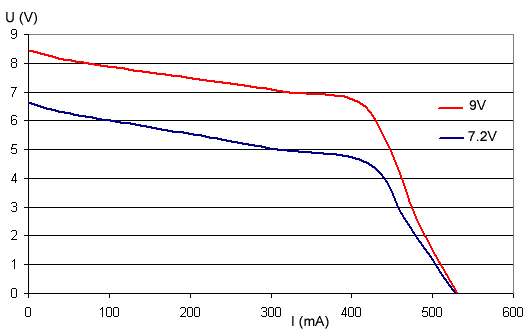
There is a significant voltage drop before reaching current limitation knee (at about 500 mA). So a stalled 71427 motor receives only about 7V at 300 mA, while two paralleled 71427 or a single 2838 almost reach current limitation (5.5V / 430mA).
Once current limitation is established (for example with a dead short), power dissipation in the driver is very high, and it quickly enters thermal shutdown mode. After that, the output cycles on/off with a period of about 1 second: the driver circuit heats up, stops output, cools down, re-enables output, heats up again and so on.
You can also see on the graph that with a dead short, the output can deliver slightly more than 500mA. So if all three outputs are shorted, total consumed current is more than 1.5A, exceeding rating of the fuse that protects RCX. This condition should not happen in normal circumstances, even with all three outputs loaded with 2 stalled 71427 motors...
I also had a look to current output capabilities of 8475 RC Race Buggy. Its main output drives two paralleled 5292 motors that consumes more than 3A when stalled so it has to be beefy ! And indeed it seems to have a current limitation of about 4A, and a thermal shutdown providing on/off cycling like RCX motor driver.
Getting maximum mechanical power from RCX output
Using an illimited power supply (fresh batteries for example), a DC motor provides maximum mechanical power when loaded at half of its stall torque. This is also the load where rotating speed is half of no-load speed (this assumes ideal conditions such as low internal friction, but according to load curves showed above, this is exact enough to be useful).
But with RCX output, some voltage drop occur as current increases, and current limitation can also trigger in if two motors under heavy load are paralleled on the same output.
Here are the curves showing mechanical power versus load torque for various motor combinations. The RCX was externally powered from a regulated power supply, and I measured mechanical power at 9V (equivalent to 6 alkaline batteries) and 7.2V (6 NiCd or NiMH rechargeable batteries).
RCX powered by an external regulated power supply through two fake batteries. Caution: I shall not be held responsible if you burn your RCX with incorrect voltage or bad polarity ! |
|
The fake batteries where assembled from the sawed ends of old alkaline batteries, maintained at the right spacing with rods of hot melting glue. Caution: batteries contain hazardous chemicals that can be dangerous for your health. Open them at your own risk and only if you know what you are doing!!! |
You can see from the curves that although RCX can be operated from NiMH batteries, the lower supply voltage translates in a 40% cut down of available mechanical power .
Single motor curves
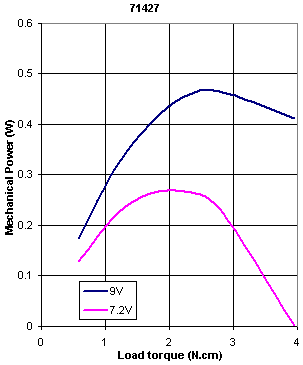
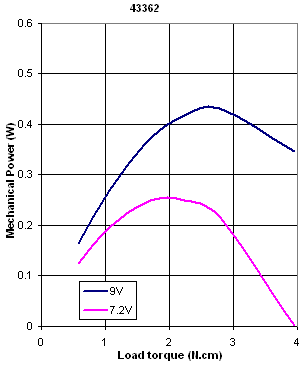

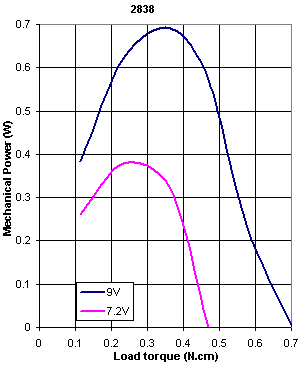
Paralleled motors curves
Two identical motor are powered from the same RCX output, and their shaft are mechanically coupled.

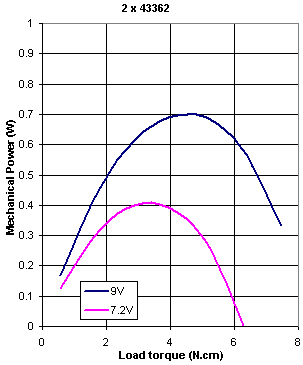
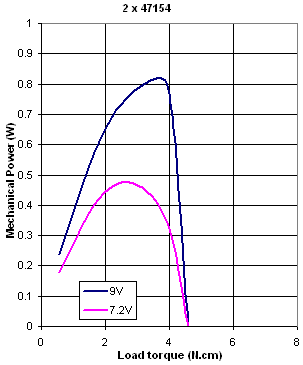
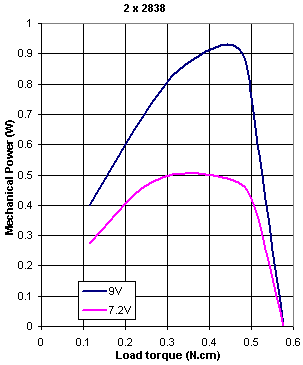
Because of the higher current consumption of 47154 and 2838 motors, using two of them on the same RCX output is not recommended, as they exceed RCX current limitation when heavily loaded. At 0.8 W, tandem 71427 provide safely the greatest mechanical power of all.
Conclusion
Each of these motors has unique characteristics which makes it more or less suitable for different applications.
Caution
! Though I tested motors with a 12V supply, |
![]()

![]()
![]()
![]()
